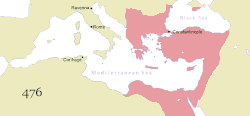Byzantine Empire under the Macedonian dynasty
[3] The iconoclast movement experienced a steep decline; this favoured its soft suppression by the emperors, and mitigation of the religious strife that had drained resources in previous centuries.The Eastern Orthodox Church establishment began to support the imperial cause, and the state limited the power of the landowning class in favour of agricultural small-holders, who made up an important part of the military.Using present-day Tunisia as their launching pad, the Muslims conquered Palermo in 831, Messina in 842, Enna in 859, Syracuse in 878, Catania in 900 and the final Greek stronghold, the fortress of Taormina, in 902.These drawbacks were later counterbalanced by a victorious expedition against Damietta in Egypt (853), the defeat of the Emir of Melitene (863), the confirmation of the imperial authority over Dalmatia (867) and Basil I's offensives towards the Euphrates (870s).Muslims received assistance however from the Paulician sect, which had found a large following in the eastern provinces of the Empire and, facing persecution under the Byzantines, often fought under the Arab flag.Despite this revenge, the Byzantines were still unable to strike a decisive blow against the Muslims, who inflicted a crushing defeat on the imperial forces when they attempted to regain Crete in 911.In 941 they appeared on the Asian shore of the Bosporus, but this time they were crushed, showing the improvements in the Byzantine military position after 907, when only diplomacy had been able to push back the invaders.The vanquisher of the Rus' was the famous general John Kourkouas, who continued the offensive with other noteworthy victories in Mesopotamia (943): these culminated in the reconquest of Edessa (944), which was especially celebrated for the return to Constantinople of the venerated Mandylion.The soldier emperors Nikephoros II Phokas (reigned 963–69) and John I Tzimiskes (969–76) expanded the empire well into Syria, defeating the emirs of north-west Iraq and reconquering Crete and Cyprus.[2] Many successes had been achieved, ranging from the conquest of Bulgaria, to the annexation of parts of Georgia and Armenia, to the total annihilation of an invading force of Egyptians outside Antioch.




Macedonian dynastyAncient GreekBasil IIConstantinopleMedieval GreekOld AlbanianRomance languagesArmenianOld Church SlavicSouth Slavic languagesSyriac languageEastern Orthodox ChurchEmperorBasil ITheodora PorphyrogenitaMichael IIIByzantine Empire under the Amorian dynastyFirst Bulgarian EmpireByzantine Empire under the Doukas dynastyCounty of Apulia and CalabriaCatepanate of RasDukljaHistory of the Byzantine EmpireRoman EmpireDominateTetrarchy eraConstantinian–Valentinianic eraConstantinian dynastyValentinianic dynastyTheodosian eraLeonid eraJustinian eraHeraclian eraTwenty Years' AnarchyIsaurian eraNikephorian eraAmorian eraDoukid eraKomnenian eraAngelid eraFourth CrusadeLatin ruleLatin EmpirePrincipality of AchaeaNicaeaEpirusThessalonicaTrebizondTheodoroPalaiologan eraDespotate of the MoreaDecline of the Byzantine EmpireFall of ConstantinopleTimelineGovernmentEconomyMacedonianAdriatic SeaSouthern ItalySamuil of BulgariaGolden AgeByzantiumMacedonian RenaissanceByzantine artmosaicsJustinianBasil ITheoktistosiconoclastRomanos I LekapenosEarly Muslim conquestsBosporusSicilyTunisiaPalermoMessinaSyracuseCataniaTaorminaDamiettaMeliteneDalmatiaEuphratesArab MuslimsPaulicianThessalonikisackedByzantine renegadeLaodiceaKievan Rus'for the first time in 860they appeared on the Asian shoreonly diplomacy had been able to push back the invadersJohn KourkouasEdessaMandylionNikephoros II PhokasJohn I TzimiskesCyprusJerusalemAleppoFatimidByzantine–Bulgarian warsSee of RomeBulgariaSimeon IBattle of BulgarophygonConstantine VIIAdrianopleLeo PhokasRomanos LekapenosBattle of AnchialusCorinthBattle of KleidonDanubeTheophanuOtto IIHoly Roman EmpirePrince OlegBlack SeaVladimir the GreatVarangian GuardScandinavianPrimary ChronicleRus'-Byzantine WarsRus'–Byzantine Treaty (907)